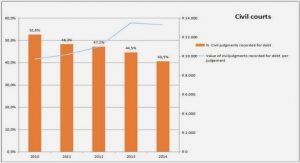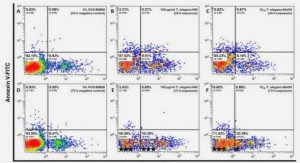Get Complete Project Material File(s) Now! »
Practical Approaches on Measurement Polyphenol Oxidase Activity
Preface
This Chapter was written as a draft review article, which describes the different techniques that are commonly-used to study the kinetics of PPOs. These include ultraviolet/visible (UV/Vis) spectrophotometry,1-5 assays using gel electrophoresis,6-7 oxygen consumption assays,8-12 assays that use radiolabelled substrates,13,14 and fluorometric assays.15,16 The use of immobilised PPO as biosensors to detect and quantify phenolic compounds is out of scope and will not be discussed in this review.
UV/Vis spectrophotometry
UV/Vis spectrophotometry is the most frequently used technique to study PPO-catalysed reactions. Oxidation of a phenolic substrate may lead to a change in the optical property of the compound. This allows the reaction to be monitored by following changes in absorbance at a certain wavelength (Figure 2.1).17 The changes in the UV/Vis absorption of the reaction follows the Beer-Lambert relationship (Equation 2.1), which relates absorbance ( ) to concentration ( ), extinction coefficient of the quinone product ( ) and light path-length ( ).17 This relationship allows the concentration of the reaction product to be quantified by the absorbance of the mixture.
One example of using UV/Vis spectrophotometry to study PPO-catalysed reactions was reported by Valero et al. Using 4-methylphenol and 4-methylcatechol as substrates, the authors studied the oxidation of the compound to 4-methylquinone by grape PPO.1 4-Methylphenol and 4-methylcatechol are colourless compounds, whilst 4-methylquinone absorbs light at a 400 nm wavelength with an extinction coefficient (ε) of 1350 M-l cm-1, thus these are ideal substrates for UV/Vis spectrophometry.3
When 4-methylphenol was used as a substrate, the authors observed a lag period at the beginning of the reaction.1,2 However, when 4-methylcatechol was used as a substrate, no such lag period was observed.3,4 Instead, a linear increase of the absorbance at 400 nm, which reflects the formation of the 4-methylquinione product, was observed. The lag period is characteristic for the monophenolase activity of many PPOs. PPOs may exist in three forms, the met, oxy and deoxy forms. The lag period observed when 4-methylphenol was used as a substrate may be explained by the formation of the met-PPO:4-methylphenol complex, which does not lead to the formation of the quinone product.
Although UV/Vis spectrophotometry can be applied to study PPO-catalysed reactions directly, the oxidised quinones can be unstable and they may polymerise to form dark coloured pigments.18 These polymerised products may be insoluble and may precipitate from the solution, thus leading to a change in the UV/Vis absorption. In order to solve this problem, an alternative spectrophotometric method was proposed. This method relies on a coupling reaction between 3-methyl-2-benzothiazolinone hydrazone (MBTH) and quinones to form a stable adduct that can be observed by UV/Vis spectrophotometry (Reaction 2.1).3-5
The MBTH method was first applied to analyse PPO diphenolase activity by trapping the product of L-3,4-dihydroxyphenylalanine (L-Dopa) oxidation. The pigment formed by MBTH-quinone was stable for at least 30 minutes. The nucleophile MBTH did not inhibit enzyme activity.12 Moreover, the extinction coefficient (ε) of the MBTH-quinone adduct was higher than the quinone itself. Thus, the MBTH assay is more sensitive owing to the higher ε and the superior stability of the complex when compared to quinone on its own.
However, not all substrates may be used with the MBTH method, as some corresponding MBTH-quinone adducts do not have high solubility in aqueous solutions,4 thus limiting the reliability of the measurements. It is therefore important to optimise the system to ensure the MBTH-coupled reaction reflects the kinetics of the PPO-catalysed reaction.
Enzyme assays with gel electrophoresis
Many reported studies of PPO used enzymes that were extracted and (partially) purified from organisms such as plants. These enzyme mixtures may contain impurity proteins. They may also contain a mixture of latent and active PPOs. In-gel activity assay is a useful technique to identify the proteins in the mixture that exhibit PPO activity. The basic principle of the assay is relatively simple. First, native gel electrophoresis is applied to separate the proteins based on their molecular weight. This is then followed by exposing them to an enzyme-specific substrate to detect enzymatic activities. The basis of this experiment is that the biological activity of the enzyme needs to be retained following electrophoretic separation.17 In the case of PPO, since its catalytic activity is not inhibited or adversely affected by 10% sodium dodecyl sulphate (SDS), SDS-polyacrylamide gel electrophoresis (SDS-PAGE) may be used for the seperation.
An alternative method is to immobilise a substrate (for example, catechol) on a chromatography paper to evaluate PPO activity (i.e. “catechol paper”). Catechol paper could be prepared by immersing a chromatographic paper in 0.5% catechol (w/v),
which is followed by a drying step at 37 C for 5 minutes. The resultant catechol paper can be stored at room temperature in a dark room until use. In this method, after gel electrophoresis, the gel was immediately pressed onto the top of a dried catechol paper (Figure 2.3). A dark brown band will be blotted onto the catechol paper as a result of the PPO-catalysed production of ο-benzoquinone. The concentration of the benzoquinone product is proportional to the colour of the PAGE-blot, which can be measured by imaging techniques.6
Overall, both in-gel activity assays presented here are useful for the identification of active PPO from a protein mixture. Although these methods can be applied (and indeed have been applied) to study the kinetics of PPO-catalysed reactions, the setup of these assays can be tedious. In addition, as the proteins were immobilised in a polyacrylamide matrix in the gel, caution must be paid when comparing the enzyme activities through in-gel assays to those obtained in solution.
Oxygen consumption assay
As oxygen is required for PPO-catalysed oxidation reactions, the measurement of oxygen consumption may also be used to follow PPO-catalysed reactions. Janovitz-Klapp et al. first demonstrated the use of an oxygen consumption assay to study the kinetics of apple PPO using a Clark-type oxygen electrode.8 The experiment was carried out in air-saturated solutions. As oxygen uptake was being measured, it was possible to measure the effect of oxygen and the phenolic substrate on the rate of the reaction. By measuring oxygen consumption at different phenolic substrate concentrations, it was found that the ‘binding’ of oxygen (determined using the Michaelis constant, KM) was independent of the concentration of the phenolic substrate (and vice versa), and that their binding likely occurred in a step-wise manner. Such information is often difficult to achieve because the consumption of oxygen is not typically measured in other assays.
1. Introduction
1.1 General perspectives
1.2 Catalytic mechanism of PPOs
1.3 The overall structure of PPO
1.4 Substrate selectivity between tyrosinase and catechol oxidase
1.5 Vitis vinifera PPO
1.6 Modulator of PPO
1.7 Reducing agents employed in pre-fermentation stage of Sauvignon Blanc grape juice
1.8 Objectives
2. Practical Approaches on Measurement Polyphenol Oxidase Activity
2.1 Preface
2.2 UV/Vis spectrophotometry
2.3 Enzyme assays with gel electrophoresis
2.4 Oxygen consumption assay
2.5 Radioenzymatic assay
2.6 Fluorescence assays
2.7 Conclusions
3. Grape polyphenol oxidase: production, purification and characterisation
3.1 Introduction
3.2 Objectives
3.3 Production of recombinant grape PPO
3.4 Purification of recombinant grape PPO
3.5 Characterisation of recombinant grape PPO
3.6 Conclusions
4. Development and application of an NMR-based assay for polyphenol oxidases
4.1 Introduction
4.2 Objectives
4.3 Development of a 1H NMR assay for PPO activity
4.4 Studying the effect of antioxidants on PPO-catalysed reactions
4.5 Inhibition assay
4.6 Conclusions
5. Investigations on the substrate selectivity of polyphenol oxidases
5.1 Introduction
5.2 Objectives
5.3 Testing the blocker residue theory using wild-type and mutant grape PPOs
5.4 Investigating the ‘second shell residue’
5.5 Conclusions and further work
6. Extraction and purification of polyphenol oxidase from Sauvignon Blanc grape
6.1 Introduction
6.2 Objectives
6.3 Method developments on PPO extraction from Sauvignon Blanc juice
6.4 Extraction and purification of PPO from Sauvignon Blanc grapes
6.5 Identification of PPO extracts
6.6 Conclusions
7. Experimental
7.1 Cloning procedures
7.2 Protein production
7.3 Protein purification
7.4 Protein concentration determination
7.5 Gel electrophoresis
7.6 Identification of purified recombinant grape PPO
7.7 Inductively coupled plasma mass spectrometry (ICP-MS)
7.8 UV/Vis measurement
7.9 NMR spectroscopy to monitor enzyme kinetics and inhibition
7.10 Virtual screening
7.11 Production and characterisation on four mutants of grape PPO
7.12 Centrifugal filter applied on concentrating Sauvignon Blanc grape juice
7.13 Extraction and purification of grape PPO from Sauvignon Blanc grape
GET THE COMPLETE PROJECT
Biochemical characterisation of polyphenol oxidase






